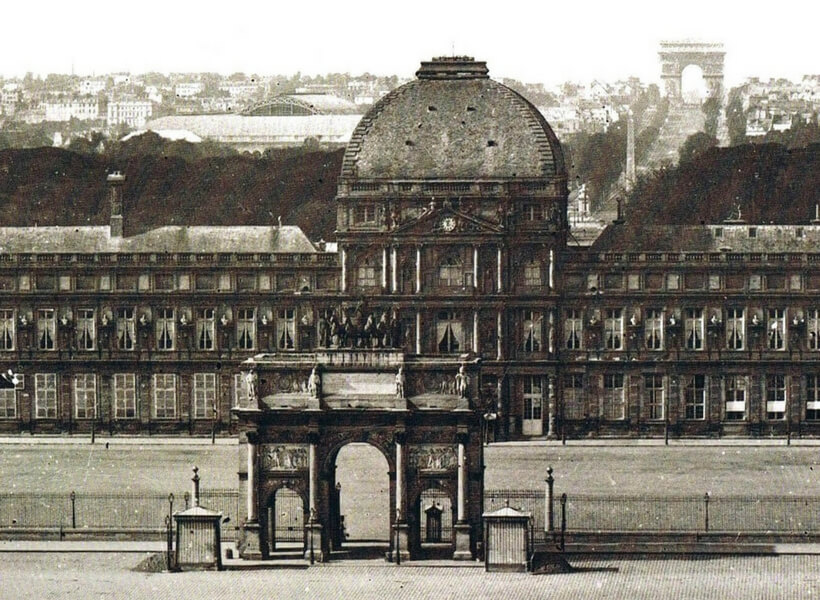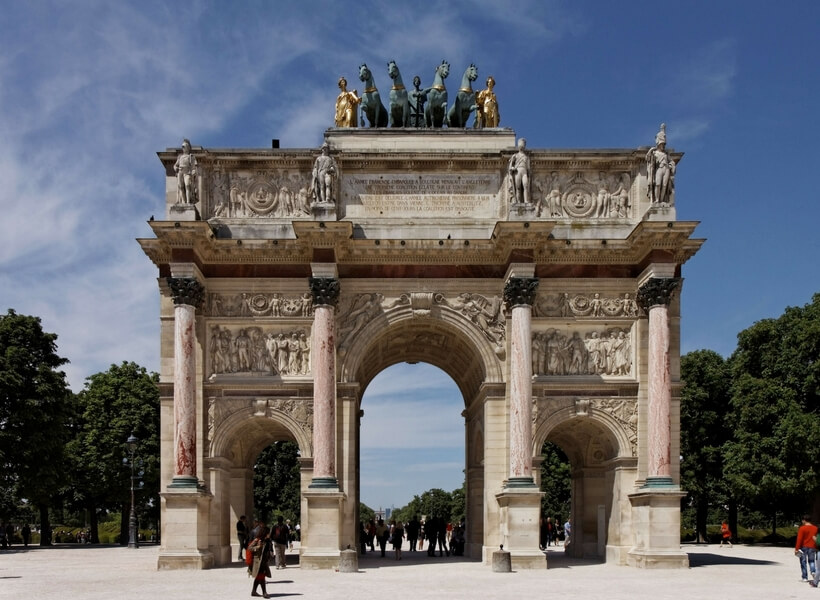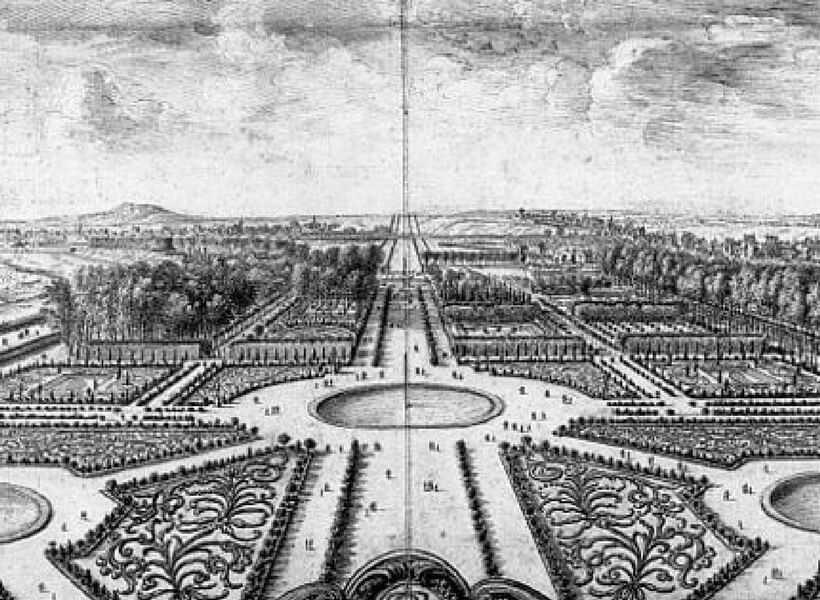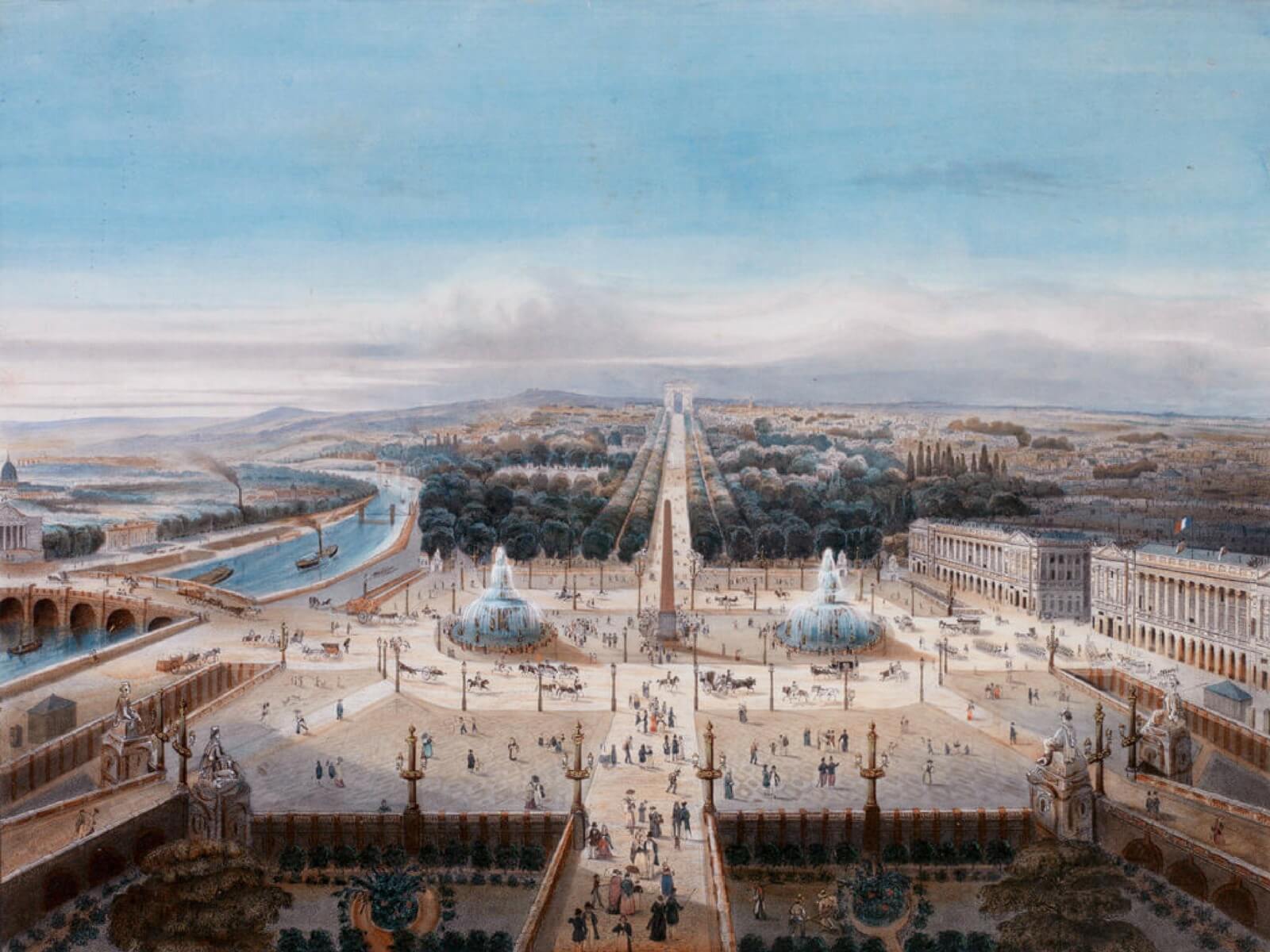Table of Contents for this Episode
Categories: French History, Paris
[00:00] This is Join Us in France Episode 182. Bonjour, I’m Annie and Join Us in France is the podcast where we talk about France, its many quirks, its history, its language, and of course, destinations in France you want to learn about because, hopefully, you’ll be visiting soon!
[00:21] Join Us in France is brought to you by Patreon supporters and Addicted to France, the small group tour company for people who want the best out of their visit to France. We have a tour coming up late May with a few spots left for Paris and I can take one more person for Normandy.
[00:43] We’ll be in Normandy over the D-Day celebrations and everything is selling-out already. If you’re interested in either the Paris or the Normandy tour, make up your mind quickly because it’s time to book hotel rooms and tickets for May and June! Also, if any of you want to join us for a day-trip to Versailles on May 25th, book it fast because that’s going to be full soon too! You can look at all of that on Addicted to France
Intro Music: Style Musette
[00:43] Quick announcement about the email extras: I haven’t send one the last 3 weeks because I didn’t have any inspiration of something that would be helpful to you. In that time lots of new people joined the email list and probably wonder why I don’t email them. Well, I only email when I have something interesting to say.
[02:03] This week-end I’ll send a good one out: I’ll be a graphic that shows the Paris Historical Axis with a list of all the monuments that are included. You’ll be able to print it as a reminder for when you eventually visit Paris. Because I know that you listen to the show with baited breath, but come on, you forget, right? So you can print the episode overview and bring it to Paris with you when you’ll need to look at it!
What Is the Paris Historical Axis?
[02:37] On today’s episode I want to ask a deeeeep philosophical question: if Paris monuments all precisely line up over 8.5 kilometers and nobody knows about it? Do they really line up?
And, more impressively, if I tell you about it, can I make them magically line up?
[03:02] But, yes, lots of monuments line up in Paris and I’m going to show it to you! Warning: Once you see this, you can never us-see it, yet this is the type of completely arcane knowledge about Paris that will probably never come-in handy, and YET, I bet you’ll go looking for it next time you go to Paris because it’s cool.
[03:30] What am I talking about?
I’m talking about the Paris Historical Axis. The WHAAAAT? The Paris Historical Axis or Axe historique de Paris AKA “la voie royale” (the Royal Road).
[03:47] A select number of French people, such as myself, of course!, know about l’Axe historique de Paris. And it’s something you can go see in person when you visit Paris, I’ll tell you exactly where to stand to see it later in the episode.

Other Major Cities Have Linear Axes
[04:03] You might be familiar with the Washington DC Axis, designed by French-born architect Pierre Charles L’Enfant. The idea is to line up major monuments to organize the city around a strong radiating avenue, symmetry, straight lines, order, power, all that.
[04:27] L’Enfant didn’t invent the concept of lining things up, he imported it from France where it has been a big deal for a long time. Washington DC does it, and so do New Delhi, Canberra, Buenos Aires and possibly others that I don’t know about.
Why Do We Like to Line Things Up?
[04:48] Lining things up perfectly is hard. I know this is trivial, but a few years ago I replaced an old fence along one side of my house. I decided I needed to get off the computer and do something manual for once and how hard could it be? It’s just a wooden fence! Yeah, no. The first section of my fence is so crooked. I got better with practice, but straight lines are not something that happen without effort and know-how.
[05:24] On a much bigger scale, when we line things up in a city, we’re saying look at me, I’m so good, I can line up things that are very far away from one another! In the case of the Paris Historical Axis, the monuments are 8 + kilometers away from one another! If it looks aligned from the sky, that proves human intelligence, right? Yes, probably. People, even the ones without OCD, like to line things up.
The Haussmannian Era in Paris
[05:55] And, of course, Paris also went through the Haussmannian era of cutting through the clutter of narrow messy old streets to get to straight wide avenues that criss-cross Paris in many directions.
[06:10] So, even when it’s hard to do, cities sometimes decide to bite the bullet and do painful improvements, just to be able to show off wide gorgeous avenues.
[06:24] But Paris started on this project in the 1500s when the city was still in its infancy relatively speaking, so at least when it comes to the Paris Historical Axis, they didn’t have to destroy anything to pull it off.
The Monuments that Make Up the Paris Historical Axis
[06:49] So let’s start with the list of monuments that are lined up today and then we’ll go into how it happened.
The Paris Historical Axis Starts with the Statue of Louis XIV at the Louvre
[06:57] When people go to the Louvre they are dazzled by the whole setting and that amazing glass pyramid by I.M. Pei just draws the eye like you wouldn’t believe. The Pyramid is at the center of the the large Plaza called Cour Napoleon.
[07:15] Now, try to ignore the Pyramid for a minute in your mind’s eye, and look to the right a little bit. There’s a statue of a man on a horse there. On the horse is Louis XIV in full glory, and that statue is the starting point of the Paris Historical Axis today!
Replicas of the Louis XIV Statues
[07:37] Extra çredit for trivia: that statue is made of lead and not bronze because it’s a replica that dates from 1988. They put the original (which was made of bronze) inside of the Louvre. There was another original copy of that statue of Louis XIV on a horse at Versailles in the garden, and that one too got put indoors (inside the Orangerie at Versailles) and replaced by a replica.
[08:10] At any rate, the Paris Historical Axis starts at the Louis XIV statue in the courtyard of the Louvre. It’s also a great meeting point if you need to meet someone in Paris because it’s easy to spot and it doesn’t normally draw a crowd 🙂
The Paris Historical Axis Ends with the Grande Arche de la Défense
[08:28] At the other end of the Paris Historical Axis is the Grande Arche de la Défense. I’ll tell you more about it at the end of the episode. And I’ll tell you how it’s going to be extended again at the end.
The Paris Historical Axis Goes Through Many Landmarks!
[08:45] So, we start at the statue of Louis XIV at the Louvre, the Arc de Triomphe du Carrousel, we go through the Garden of the Tuileries, place de la Concorde and the Louxor Obelisk, the Champs Elysées, the Arc the Triomphe, the avenue of the Grande Armée, avenue Charles de Gaulle, it goes across the River Seine with a proper bridge now, pont de Neuilly and gets to La Défense.
[09:24] The thing is, these landmarks didn’t all appear in that linear order as we’ll see in a minute.
How Did the Paris Historical Axis Start?
[09:34] How did this whole thing happen? Let’s go back in time and see if we can figure it out. It would be cool if I could tell you about a grand plan by the Knight Templars or the Illuminati or something grand that looked far into the future to make Paris the center of the universe. Or something.
[09:54] Some of the material I read in preparation for this episode certainly hints at some grand plan of universal importance. One saw vital significance in the angle of this axis compared to the geometry of the earth. I can’t do it justice here because it was pure nonsense.
But, it gave me the idea to teach you a wonderful French expression in the French tip of the week later on. The expression is “tiré par les cheveux” which means far-fetched.
[10:31] So, if there was no grand plan, what was it? I think it was really mundane.
French Kings Liked Straight Roads
[10:39] The construction of the first part of the Louvre started in 1546. French Kings who lived at the Louvre liked to go hunt in the forest of Saint Germain en Laye, 20 kilometers away to the west. And they decided they needed a straight road to go hunting. Much of this area was farmland and forest with a nice straight road in the middle.
[11:16] And when their straight road got to one of the two meanders of the River Seine between Paris and their forest at Saint Germain en Laye, they built one of these boat contraptions that crosses a river in a straight line pulled by a rope or a cable. It’s called a “bac” in French, but I don’t know what to call it in English. It’s like a raft with cables or ropes that starts on one bank of the river and pulls you to the other side with your horses or carriages. I’m sure one of you knows and will tell me what that’s called!
The Royal Road
[11:51] In any case, that straight road is how this whole thing started. They called it the Royal Road because Kings wanted it and Kings used it. So that’s why, if you’ve heard of the Paris Historical Axis at all, you may have heard it mentioned as “the Royal Road”.
Catherine de Medici and the Palace of the Tuileries
[12:11] When Catherine de Medici came into power (middle 1500s), she commissioned a palace for herself just a little west of the Louvre, it was called the Palace of the Tuileries. It isn’t there any more because it was set on fire voluntarily during the Paris Commune (May 1871) and the damage was so extensive that they decided to demolish it and move the Government to the Elysées Palace where it still is today.
[12:47] We have an old photo of it, I’ll put it on joinusinfrance.com/182 so you can have an idea of what it looked like.
[13:01] The center of the Palace of the Tuileries was the point of origin of the Paris Historical Axis at first.

Paris Used to End with the Tuileries Gardens!
[13:13] Catherine de Medici liked gardens, and the Tuileries Gardens were developed just for her. Later. After her death, André le Nôtre redesigned her Tuileries Gardens to include straight lines that extend far to the Champs Elysées.
[13:32] But, of course, under Catherine de Medici, Paris pretty much ended at the edge of the Tuileries Gardens, the rest was swamp land, it wasn’t developed. But they started draining that swamp and since the Seine river is nearby, they probably built walls to keep the water inside of the river instead of letting it overflow everywhere.
[13:56] The river Seine is very high and flooding many areas as I record this episode on January 31, 2018. So, yeah, in wet countries like France, you have to use engineering methods to keep the rivers within their path or they’ll constantly flood the area making nearby land unusable.
The Original Point of Origin of the Paris Historical Axis Was the Palace of the Tuileries
[14:32] But back to my Paris Historical Axis. There is a bit of a mystery to me about some parts of the chronology of when these landmarks were placed along the axis. While the Palace of the Tuileries was still there, that was the center of the Paris Historical Axis. But once it got destroyed (1871), they had to replace it with another starting point. They decided on the statue of Louis XIV on a horse near where the Louvre Pyramid is today.
[15:10] Was that statue in the alignment to begin with or did they have to move it to put it in the alignment after 1871? I couldn’t find that information. It’s not that important, I didn’t want to spend too much time on it, but that is an open question.
André le Nôtre Genius Garden Designer
[15:26] Louis XIV (middle of the 1600s) had a genius garden designer called André Le Nôtre. He’s the one who modified Catherine de Medici’s gardens to be all straight lines and extended the perspective to the Champs Elysées. He also designed the gardens at Versailles and many other places. He made the whole concept of French Gardens a huge thing.
Going Beyond the Tuileries
[15:57] As Paris grew, people started building beyond the Tuileries gardens all the way to the top of the Champs Elysées. Strangely enough, the Champs Elysées were designed, funded and built before the place de la Concorde even though you may remember that place de la Concorde is between the Tuileries Gardens and the Champs Elysées. And it’s a big area, it’s 21 acres.
Place de la Concorde in the 1700s
[16:21] For a long time there was no grand plan for the area we know as place de la Concorde today and it went through many iterations as happens everywhere. Le Nôtre planned and built the Tuileries and the Champs Elysées, but when he died in 1700, he hadn’t planned anything for the place de la Concorde area.
[16:42] For most of the 1700s there was a dock on the Seine river where they brought in marble from quarries all over France and probably Italy and all that. That dock was right where the place de la Concorde is today. Marble was big business, that’s probably one of the reasons why they left the area alone.
[17:04] There was also a gabelle tax post (that’s a tax on salt) and, loveliest of all, there were two big open sewers that served the Champs Elysées and the Tuileries that went right into the river. Oh yeah, Paris has cleaned up a lot!
[17:25] In 1753 they organized an architectural competition to make something nice of this mixed use yucky area of the place de la Concorde. And 10 years later they’ve moved the businesses, covered the sewers and placed a grand statue of Louis XV on a horse. And, of course, they placed that statue in the axis of the Tuileries Gardens and the Champs Elysées, so again, they continued aligning things on purpose.
There Are Two Arcs de Triomphe in Paris
[18:02] There are two Arcs de Triomphe in Paris, the construction of both started in 1896 and they were both erected to the glory of our favorite megalomaniac Napoleon. Yes, Napoleon needed TWO monuments to his glory built at the same time and both on the Paris Historical Axis, that goes without saying.
The Arc de Triomphe du Carrousel
[18:28] The first Napoleon Arc de Triomphe is near the Louvre and is called the Arc de Triomphe du Carrousel. It’s half the size of the other one on top of the Champs Elysées, but it’s twice as cute, so I think you should go look at it.
[18:44] It’s got lovely green and gold horses on top and 4 lovely pink columns. It’s Corinthian style, they completed it quickly, within 2 years. It was used as the backdrop for impressive military shows that Napoleon liked so much. Today you can look around, it’s a nice quiet area, great for photos. And another good place to meet people in Paris because you can’t miss it and it’s quiet.

The Arc de Triomphe de l’Étoile
[19:13] The Arc de Triomphe de l’Étoile is at the top of the Champs Elysées, it’s twice as big as the other one, they also started building it in 1806, but it took 30 years to complete, so it wasn’t inaugurated until 1836. The Paris Historical Axis goes right through the center of it.
[19:42] You can climb to the top of that Arc de Triomphe de l’Étoile, I’ve never done it because I didn’t get around to it when I was younger and now I have bad knees, but the view from the top is interesting.
[19:52] If you go, pay attention to the madness of the traffic going around the roundabout. It will look like chaos to you, but it’s actually following the rules of the right-hand-side priority that we discussed in episode 16 of the podcast. This is a prime example why I don’t recommend people drive in Paris. People who learned to drive in France like myself know what to do, but others are completely flustered by it and it’s dangerous.

1836: A Great Year for the Paris Historical Axis
[20:26] Two monuments were added to the Paris Historical Axis in 1836: the first in July 1836 and the second in October 1836.
The Arc de Triomphe de l’Étoile
[20:40] The Arc the Triomphe de l’Étoile on top of the Champs Elysées that I just talked about.It was inaugurated in July 1836.
The Louxor Obelisk
[20:50] They raised the Louxor Obelisk on the Place de la Concorde on October 25, 1836 and they had planned all along to line it up with the center of the Tuileries Gardens and the Paris Historical Axis. It’s uncanny how well all these things line up! French engineers are pretty good I say!

How Far Apart Are the Paris Historical Axis Landmarks?
[21:14] The Jardin des Tuileries proper is 1 kilometer long. But between the Louis XIV statue and the Arc de Triomphe du Carrousel, that’s 500 meters give or take. Then to the Louxor Obelisk, that’s probably 1.5 kilometers away. Between the Obelisk and the Arc de Triomphe on the Champs Elysées, that’s another 2 kilometer. Then there’s a big jump of 4 kilometers to the Grande Arche in la Défense.
[21:53] When you’re standing at the Louis XIV statue, you may or may not notice the alignment. I don’t think it’s easy to see from the ground there. It’s easier to see from the Arc de Triomphe du Carrousel. But try and send me a photo if you can see it!
The Distance Between the Arc de Triomphe and the Grande Arche de la Défense
[22:16] Then the next major landmark is the Arc de Triomphe and that’s 3 kilometers away from the Arc du Carrousel. The Arc de Triomphe is 50 meters tall, so it’s again fairly easy to see because it’s twice as tall as the previous two monuments on our Historical Axis of Paris.
[22:35] Where it gets tricky to see without looking at it from high up is the next monument on the Historical Axis of Paris, la Grande Arche. If you’re standing in front of the Carrousel, you are 8 kilometers away from La Grande Arche, and even though the Grande Arche is taller (110 meters) 8 kilometers is too far.
[22:56] So we know they line up, but you need a drone to see it and they won’t let me fly a drone in Paris, so, oh well.
The Size of the Monuments on the Paris Historical Axis Get Bigger and Bigger
[23:14] The Louis XIV statue is small(ish). I couldn’t find the exact size of it, but it’s probably 6 to 8 meters tall. The Arc de Triomphe du Carrousel is 20 meters tall, the Obelisk is 23 meters tall and the Arc de Triomphe de l’Étoile is 50 meters tall. That’s what makes the alignment fairly easy to see, at least between the two Arcs de Triomphe. To have a visible perspective, you need an increase in size or it won’t be visible.
What Is the Best Place to See the Historical Axis of Paris?
[23:40] Go in front of the Arc de Triomphe du Carrousel, the green horses are facing you, and on a clear day you can see the Louxor Obelisk and the Arc de Triomphe. I suppose you might see the Grande Arche de la Défense, but it’s 8 kilometers away, so it’s probably a stretch. I’ve never been able to see it!
Grand Arche de la Défense, Worth a Visit?
[24:05] While we’re talking about the Grande Arche, let me address this: is it worth a visit? My answer is NO.
Unless they make significant changes in the future, it’s not worth schlepping all the way there just to see the inside of a modern building. The Grande Arche was added in 1990, it hasn’t aged well. You can get in an elevator to go to the top and see Paris from up there, that’ll cost you 15€. They often have minor exhibits what cost a few euros more.
[24:42] I’ve been there a few times for work, I know they have a cool Christmas Market on the plaza in front of the Grande Arche, those are good reasons to go. But going just to see it, in my opinion, not worth it.
How’s the view from the top of the Grande Arche?
[24:57] It’s cool, but you are 8+ kilometers away from the Louvre and the Eiffel Tower, that’s too far for most eyes or zoom lenses. I went up to the roof once, I never need to do that again.
[25:14] By comparison, the Tour Montparnasse is only 3 kilometers away from the Eiffel Tower, the view is better from there, but even there, to get a decent photo you need a 200 mm zoom lens. So only go if you have a good reason to go.

Conclusion
[25:33] So, there you have it, the Paris Historical Axis. It starts with the Statue of Louis XIV at the Louvre, includes the Arc de Triomphe du Carrousel, used to include the Palais des Tuileries which has since disappeared, goes through the Louxor Obelisk on place de la Concorde, up the Champs Elysées and through the center of the Arc de Triomphe, through some landmarks that are too close to the ground to see and through the middle of the Grande Arche de la Défense.
Who Created the Paris Historical Axis?
[26:07] As, as we have seen, all of these monuments appeared at different times, but there was always a wish to line them up with the old Royal Road and center them on the Palace of the Tuileries commissioned by Catherine de Medici.
[26:24] So can we say she created the Paris Historical Axis? No really. I think Le Nôtre had more of a thing for long perspectives and straight lines. But I don’t know who gets the credit, lots of people do I’m sure.
Possible Future Extension of the Paris Historical Axis
[26:48] Some day I think it will include a large monument on the place Nelson Mandela in Nanterre, but I haven’t heard of anything specific yet. Next megalomaniac president we get in France will definitely fund something big! And it will have to be big because for perspective to work, the bigger the distance, the bigger the monument has to be.
Go See the Paris Historical Axis!
[27:43] If you want to see it for yourself, go to the Louvre, stand in front of the statue of Louis XIV. If you can’t see it from there, try it from the Arc de Triomphe du Carrousel nearby. Then walk up the Tuileries gardens and across to the place de la Concorde and the Louxor Obelisk. You could keep going up the Champs Elysées and to the Arc de Triomphe de l’Étoile, but that’s where I get tired and hop on a bus up the Champs Elysées. I’m not a shopper, but if you are, walking might be nice.
[28:22] Whatever you decide to do, one thing is for sure: the Paris Historical Axis is a fun silly thing to know about and it’s even better to see it in person. I’ve got all sorts of maps and photos for you to enjoy it vicariously on the website for the show, and those really help to visualize it.
Thank You for Your Support!
[28:44] Thank you Mike Capone, Saundra Hendricks, Ruberta Burke, and Erin Dombrowski for pledging to support the show on Patreon this week. Wow, 4 new patrons in one week, that’s not happened for a long time, I’m so glad you like the show! And my thanks also to all the patrons who support the show month after month, you guys rock! To see the different ways you can support the show visit this page.
Personal Update
[29:17] I have been calling tour members so I can get to know them a little bit. Tour members know me and Elyse because they’ve been listening to podcast episodes, but we have no idea who you are until we meet you! Again, I am delighted with the caliber people who are coming on this tour and really look forward to spend time showing off my country to you!
[29:41] No other tour company that I know of gives you a chance to get to know the tour guides before you spend a week with them. And that makes a big difference because some of the tour guides I’ve met I wouldn’t want to spend more than an hour with them, let alone a week!
[29:57] I know most of you find the podcast because you have specific plans to come to France and you need information on Paris or one of the many other places we’ve talked about. We’re happy sharing all the info we know with you because we want you to have a fantastic time in France whether you tour with us or not.
[30:17] So, why do we even offer tours if our listeners are looking for information on how tour by themselves? Well, some of you want to come to France really badly, but you travel alone because your significant other doesn’t like to travel as much as you do, or you’re single, or widowed, or you keep making plans to go, but they always fall through because life happens. Some of you travel with family or friends, but you don’t have the time to put together a great tour because that’s a lot of work! That’s why we offer Addicted to France tours! It’s a fun small side activity for us.
[30:57] Some of you want to see France with a local. It’s always better with a local, right? I don’t sound like a French person right off the bat, but I am French born and raised, and French with a Toulouse accent to boot. They think that’s adorable in Paris and I play that card for all it’s worth. You’ve heard of haughty waiters in France? Nobody’s ever haughty with me because I make them smile. That’s how I get what I want and what my customers want.
[31:30] Don’t stay home because planning a trip to France is overwhelming or because you’re worried about traveling alone. Come on our tour, we’ll take great care of you, you’ll see my France and it’s a great place to be! And make up your mind fast because May is coming up quickly, the Dordogne tour in the fall is already sold out and we won’t offer another Paris tour until 2019.
[31:58] On a much darker note, I also want to say thank you to all of you who’ve expressed condolences on the passing of my dog Luna. I mentioned her on the show last week because she was noisy while I was recording even thought she was right next to me. She was almost 15 and she had major neurological problems probably due to a brain tumor. We didn’t do the MRI to confirm the diagnosis because at her age, no matter what the cause was, the treatment was going to be the same and there are no miracle cures.
32:43] She spent the whole time I was recording being upset, growling softly, she was really anxious. With hindsight, I realize that she was hours away from totally losing control over her body, and I mean she went from being able to get around with some assistance to having no idea what to do with her legs, where up and down was, unable to stand for even a second, and all of that within the span of 2 hours.
[33:12] I am now dogless for the first time in 23 years. Let’s see how long that lasts. I’ll be able to do more with guide dogs now for sure. Be good to your pets, they bring so much into our lives and they don’t live long enough no matter how long they live.
Luna loved to walk. She never went to Paris, but I bet she would have liked the Paris Historical Axis as much as I do.
French Tip of the Week
[33:38] C’est tiré par les cheveux. Literally that means “pulled by the hair” or forced. If you drag someone by their hair, you are clearly forcing them right? Who does that BTW, that’s awful! Anyway, the etymology went from “pulled by the hair” to “forced” to “far-fetched”. It’s a really common expression that you will hear frequently in France because we’re a bunch of skeptics who upon hearing something will naturally not believe it. So here you go: c’est tiré par les cheveux, it is far-fetched!
How to Contact the Show
[34:31] The best way to connect with me is via email annie@joinusinfrance.com. You can also ask your questions on the Join Us in France Closed Group on Facebook, a lively place to be with lots of helpful folks who know Paris well.
Misc. Updates
[35:11] I’m making progress on the new website, getting to the point where I might launch it even if I haven’t transfered as many of the episodes as I’d like because it’s taking too long! Those of you who are subscribed to the podcast with whatever App you are listening to right now will continue to have access to all new and old episodes, nothing will change for subscribers. But if you’re not subscribed, I recommend you do so you don’t miss anything even when I pull the trigger too soon on the website!
Next Week on the Podcast
[35:46] Next week on the podcast, an episode with Elyse that will be an overview of why you should also come visit our home in Toulouse. We’re happy to meet you in Paris or Normandy, but get this: we have a wine bar in Toulouse that was voted the best wine bar in the world last year. And it’s right next to a wonderful salon de thé or tea shop. Strangely, I’ve been to the tea shop many times, but never to the wine bar. I’ll be dragging my husband there next week-end. Poor husband, eh?
[36:23] Anyway, I hope you all have a wonderful week of planning your next trip to France and daydreaming about France and do join us on a tour, you’ll have the time of your life! Au revoir!

Subscribe to the Podcast
Apple YouTube Spotify RSSSupport the Show
Tip Your Guides Extras Patreon Audio ToursRead more about this transcript
Episode PageCategories: French History, Paris


